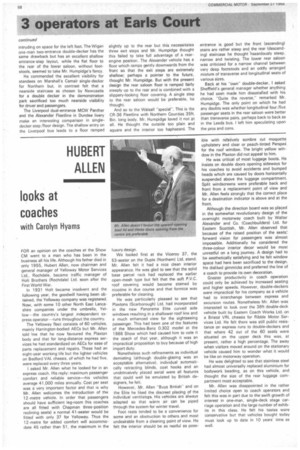HUBERT ALLEN
Page 60

If you've noticed an error in this article please click here to report it so we can fix it.
looks at coaches
with Carolyn Hyams
FOR an opinion on the coaches at the Show CM went to a man who has been in the business all his life. Although his father died in only 1955, Hubert Allen, now chairman and general manager of Yelloway Motor Services Ltd., Rochdale, became traffic manager of Holt Brothers IRochdale) Ltd. soon after the First World War.
In 1931 Holt became insolvent and the following year, the goodwill having been obtained, the Yelloway company was registered. Now, with some 10 other North East Lancashire companies under the umbrella, Yellow----the country's largest independent express operator -runs throughout the country.
The Yelloway fleet consists of 60 vehicles, mainly Harrington-bodied AECs but Mr. Allen told 'me that he now favoured the, Plaxton body and that for long-distance express services he had standardized on AECs for ease of parts replacement and repairs. These had an eight-year working life but the lighter vehicles on Bedford VAL chassis, of which he had five, were replaced every three years.
I asked Mr. Allen what he looked for in an express coach. His reply: maximum passenger comfort and reliable service—his vehicles average 41,000 miles annually. Cost per seat was a very important factor and that is why Mr. Allen welcomes the introduction of the 12-metre vehicle. In order that passengers should have sufficient leg-room (his coaches are all fitted with Chapman three-position reclining seats) a normal 41-seater would be fitted with only 37 for Yelloway. Thus the 12-metre for added comfort will accommodate 45 rather than 51, the maximum in the luxury design.
We looked first at the Viceroy 37, the 53-seater on the Duple (Northern) Ltd. stand. Mr. Allen felt it had a nice clean interior appearance. He was glad to see that the solid base parcel rack had replaced the earlier open-mesh type but felt that the soft P.V.C. roof covering would become stained by nicotine in due course and that formica was preferable for cleaning.
He was particularly pleased to see that Plaxtons (Scarborough) Ltd. had incorporated in the new Panorama Elite curved side windows resulting in a shallower roof line and a much enhanced view for the sightseeing passenger. This had been one of the features of the Mercedes-Benz 0.302 model at the 1966 Show which had caused him to vote it the coach of that year, although it was an impractical proposition to buy because of high import duty.
Nonetheless such refinements as individual demisting (although double-glazing was art acceptable alternative), individual automatically retracting blinds, coat hooks and an unobtrusively placed aerial were all features that could well be emulated by British designers, he felt.
However., Mr. Allen "Buys British" and on the Elite he liked the discreet placing of the individual ventilators. His vehicles are always adapted so that warm air can be piped through the system for winter travel.
Foot rests tended to be a convenience for some and an obstruction to others and most undesirable from a cleaning point of view. He felt the interior should be as restful as poss
ible with relatively sombre cut moquette upholstery and clear or peach-tinted Perspex for the roof window. The bright yellow window in the Plaxton did not appeal to him.
He was critical of most luggage boots. He insists on double doors opening sideways for his coaches to avoid accidents and bumped heads which are caused by doors horizontally suspended above the luggage compartment. Split windscreens were preferable back and front from a replacement point of view and Mr. Allen feels strongly that the correct place for a destination indicator is above and at the front.
Although the direction board was so placed in the somewhat revolutionary design of the overnight motorway coach built by Walter Alexander and Co. (Coachbuilders) Ltd. for Eastern Scottish, Mr. Allen observed that because of the raised position of the seats:. forward vision for passengers was almost impossible. Additionally he considered the three-colour interior decor would be most unrestful on a long journey. A design had to be aesthetically satisfying and he felt window space had here been sacrificed to the design. He disliked gimmicks and preferred the line of a coach to provide its own decoration.
Greater productivity in coach operation could only be achieved by increased seating and higher speeds. However, double-deckers were impractical for his company as a vehicle had to interchange between express and excursion routes. Nonetheless Mr. Allen was interested to look over the 36ft double-deck vehicle built by Eastern Coach Works Ltd. on a Bristol VRL chassis for Ribble Motor. Services Ltd. He felt there was still public resistance on express runs to double-deckers and that where 42 out of the 60 seats were situated on the upper deck this was, at present, rather a high percentage. The sway when visitors moved around on the stationary vehicle caused him to wonder what it would be like on motorway operation.
He was delighted to see that stainless steel had almost universally replaced aluminium for bodywork beading, as on this vehicle, and thought the size of the rear luggage compartment most acceptable.
Mr. Allen was disappointed in the rather limited choice open to coach operators and felt this was in part due to the swift growth of interest in one-man, single-deck stage carriage operation and the large number of exhibits in this class. He felt his tastes were conservative but that vehicles bought today must look up to date in 10 years' time as well.
































































































































































































